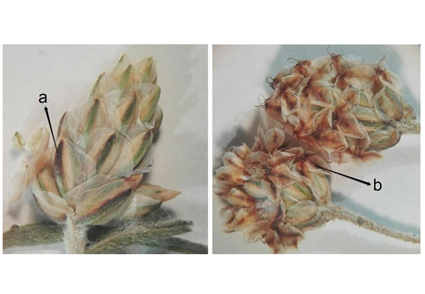Abstract
Plantago ovata (Plantaginaceae) is a medicinal plant cultivated extensively in Western Asia for seed husk known as blonde Psyllium or Isabgol. Taxonomy of P. ovata is controversial at both species level and variety recognition for both the Old and New World. There has been no infra-specific rank recognition for P. ovata in Iran. Therefore, we attempted to recognize the variety of P. ovata of Iran for the first time by using both morphological and molecular data. We used internal transcribed spacerregion (ITS) to estimate the level of genetic variability in P. ovata and also suggest the potential ancestral area of distribution and provide the probable time for P. ovata dispersal. We identified P. ovata variety decumbens as the P. ovata plant growing in Iran. Data obtained separated Asian Plantago plant samples from African and North American plants, due to sequence divergence. We obtained the time of the divergence for these two groups to be around 5 M years ago and RASP analysis revealed that Iran is the probable ancestral area for the occurrence of Asian Plantago.
References
Afshar, F., Sheidai, M., Talebi, S.M.&Keshavarzi, M. (2015) Bayesian and Multivariate Analyses of combined molecular and morphological data in Linum austriacum (Linaceae) populations: Evidence for infraspecific taxonomic groups. Biodiversitas 16 (2): 179–187. https://doi.org/10.13057/biodiv/d160213
Bassett, I.J.& Baum, B.R. (1969) Conspecificity of Plantago fastigiata of North America with P. ovata of the Old World. Canadian Journal of Botany 47: 1865–1868. https://doi.org/10.1139/b69-273
Dhar, M.K., Kaul, S., Sareen, S.&Koul, A.K. (2005) Plantago ovata: genetic diversity, cultivation, utilization and chemistry. Plant Genetic Resources 3 (2): 252–263. https://doi.org/10.1079/PGR200582
Drummond, A.J., Rambaut, A. & Xie, W. (2010a) BEAUti (version 1.6.1) [computer program]. Available from: http://beast.bio.ed.ac.uk (accessed 22 August 2022)
Drummond, A.J., Rambaut, A. & Suchard, M.A. (2010b) BEAST (version 1.6.1) [computer program].Available from: http://beast.bio.ed.ac.uk (accessed 22 August 2022)
Goncalves, S. & Romano, A. (2016) The medicinal potential of plants from the genus Plantago (Plantaginaceae). Industrial Crops and Products 83: 213–226. https://doi.org/10.1016/j.indcrop.2015.12.038
Hong, S.W.P. & Jury, S.L. (2011) Phylogeny and divergence times inferred from rps16 sequence data analyses for Tricyrtis (Liliaceae), and endemic genus of north-east Asia. AoB Plants 2011: plr025. https://doi.org/10.1093/aobpla/plr025
Joy, J.B., Liang, R.H., McCloskey, R.M., Nguyen, T. & Poon, A.F.Y. (2016) Ancestral Reconstruction. PLOS Computational Biology 12 (7): e1004763. https://doi.org/10.1371/journal.pcbi.1004763
Kazmi, M.A. (1974) Plantaginaceae. In: Nasir, E. & Ali, S.I. (Eds.) Flora of Pakistan. No. 62. Islamabad. pp. 1–21
Kotwal, S., Dhar, M.K., Kour, B., Raj, K. &Kaul, S. (2013) Molecular markers unravel intraspecific and interspecific genetic variability in Plantago ovata and some of its wild allies. Journal of Genetics 92: 293–298. https://doi.org/10.1007/s12041-013-0240-4
Kour, B., Kotwal, S., Dhar, M.K. &Kaul, S. (2016) Genetic diversity analysis in Plantago ovata and some of its wild allies using RAPD markers. Russian Agricultural Sciences 42 (1): 37–41. https://doi.org/10.3103/S1068367416010055
Križman, M., Jakše, J., Bari?evi?, D., Javornik, B. & Prošek, M. (2006) Robust CTAB-activated charcoal protocol for plant DNA extraction. Acta agriculturae Slovenica 87 (2): 427–433
Kumar, S., Stecher, G.K. & Tamura, K. (2016) MEGA7: Molecular Evolutionary Genetics Analysis version 7.0 for bigger datasets. Molecular Biology and Evolution 33 (7): 1870–1874. https://doi.org/10.1093/molbev/msw054
Miguel, A. (2015) Trends in substitution models of molecular evolution. Frontiers in Genetics 6: 00319. https://doi.org/10.3389/fgene.2015.00319
Meyers, S.C. & Liston, A. (2008) The biogeography of Plantago ovata Forssk. (Plantaginaceae). International Journal of Plant Sciences 69 (7): 954–962. https://doi.org/10.1086/589699
Mosaferi, S., Sheidai, M., Keshavarzi, M. &Noormoammdi, Z. (2015) Genetic diversity and morphological variability in Polygonum aviculare s.l. (Polygonaceae) of Iran. Phytotaxa 233 (2): 166–178. https://doi.org/10.11646/phytotaxa.233.2.4
O’Dell, R.E.&Rajakaruna, N. (2011) Intraspecific Variation, Adaptation, and Evolution. In: Harrison, S. (ed.) Serpentine: The Evolution and Ecology of a Model System. University of California Press. pp. 96–137. https://doi.org/10.1525/california/9780520268357.003.0005
Patzak, A. & Rechinger, K.H. (1965) Plantaginaceae. In: Rechinger, K.H. (ed.) Flora Iranica 15. Graz:Academische Druck und Verlagsantalt. pp. 1–21.
Rambaut, A. & Drummond, A.J. (2007) Tracer, version 1.5. Available from: http://beast.bio.ed.ac.uk/Tracer (accessed 22 August 2022)
Rambaut, A. (2009) FigTree (v1.3.1) [computer program]. Available from: http://tree.bio.ed.ac.uk/software/figtree (accessed 22 August 2022)
Sheidai, M., Taban, F., Talebi, S.M. &Noormohammadi, Z. (2016) Genetic and morphological diversity in Stachys lavandulifolia (Lamiaceae) populations. Biologija 62 (1): 9–24. https://doi.org/10.6001/biologija.v62i1.3286
Song, J., Cui, B.K. (2017) Phylogeny, divergence time and historical biogeography of Laetiporus (Basidiomycota, Polyporales). BMC Ecology and Evolution 17: 102–114. https://doi.org/10.1186/s12862-017-0948-5
Spellerberg, I.F. & Sawyer, W.D. (1999) An introduction to applied biogeography. Cambridge University Press: New York.
Stebbins, G.L. & Day, A. (1967) Cytogenetic evidence for long continued stability in the genus Plantago. Evolution 21: 409–428. https://doi.org/10.1111/j.1558-5646.1967.tb03399.x
Swofford, D.L. (2002) PAUP* Phylogenetic Analysis Using Parsimony (*and Other Methods). Version 4. Sinauer Associates, Sunderland, Massachusetts. https://doi.org/10.1111/j.0014-3820.2002.tb00191.x
Tabaripour, R., Sheidai, M., Talebi, S.M. & Noormohammadi, Z. (2018) Genetic divergence and speciation within Ziziphoracapitata (Lamiaceae): Molecular and micro morphological evidences. Biodiversitas 2: 667–675. https://doi.org/10.13057/biodiv/d190250
Tamura, K., Peterson, D., Peterson, N., Stecher, G., Nei, M. & Kumar, S. (2011) MEGA5: Molecular Evolutionary Genetics Analysis using Maximum Likelihood, Evolutionary Distance, and Maximum Parsimony Methods. Molecular Biology and Evolution 28: 2731–2739. https://doi.org/10.1093/molbev/msr121
Vahabi, A.A., Lotfi, A., Solouki, A.M. & Bahrami, S. (2008) Molecular and Morphological Markers for the Evaluation of Diversity Between Plantago ovata in Iran. Biotech 7: 702–709. https://doi.org/10.3923/biotech.2008.702.709
White, T.J., Bruns, T., Lee, S. & Taylor, J.W. (1990) Amplification and direct sequencing of fungal ribosomal RNA genes for phylogenetics. In: Innis, M.A., Gelfand, D.H., Sninsky, J.J. & White, T.J. (eds.) PCR protocols: a guide to methods and applications. Academic Press, San Diego, pp. 315–322. https://doi.org/10.1016/B978-0-12-372180-8.50042-1
Yu, Y., Harris, A.J. & He, X.J. (2010) S-DIVA (Statistical Dispersal-Vicariance Analysis): A tool for inferring biogeographic histories. Molecular Phylogenetics and Evolution 56 (2): 848–850. https://doi.org/10.1016/j.ympev.2010.04.011
Yu, Y., Harris, A.J., Blair, C., He, X.J. (2015) RASP (Reconstruct Ancestral State in Phylogenies): a tool for historical biogeography. Molecular Phylogenetics and Evolution 87: 46–49. https://doi.org/10.1016/j.ympev.2015.03.008


